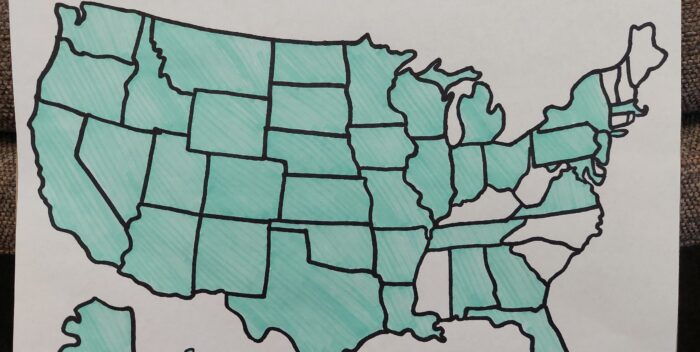The benefits of a 50 percent out-of-state undergrad student body
This year’s undergraduate students represent 39 U.S. states (shaded blue), plus four Canadian provinces and 13 foreign countries. The data (above) is provided by the registrar’s office as of Aug. 6, 2025.
By Nora Betts
Managing Editor
Photo design by Nora Betts
Did you know that approximately 50 percent of full-time undergraduate students at Concordia are from Nebraska? Students at Concordia represent 39 U.S. states, 4 Canadian provinces, and 13 foreign countries.
This data is based on home addresses provided to the registrar. Children of missionaries who live abroad but have a U.S. address, for example, may not have their countries represented on this list.
The graphic to the right shows the home states and countries of 1,275 full-time undergrads for the 2025-2026 academic year, according to the registrar’s office as of Aug. 6. The most-represented states after Nebraska are Missouri, Colorado, Kansas and Texas.
Do most students stay in-state for college?
A 2025 report by Melanie Hansen published by the Education Data Initiative offers statistics about in-state and out-of-state college students. Some states have many students who go away to college, while others keep most of their students in-state.
According to the data, 51.3 percent of enrolled students from Alaska travel out-of-state for school, followed by 50.1 percent of students from New Hampshire. The states where the lowest percentage of students travel out-of-state are Utah at 11.4 percent and California at 12.5 percent.
Nebraska falls somewhere in the middle, with 24.9 percent of college students from Nebraska traveling out-of-state for college.
What do Nebraska colleges look like?
When it comes to Nebraska colleges as a whole, nearly 3 of 4 students are Nebraska residents. According to Hansen’s report, among full-time students at Nebraska postsecondary institutions, 74 percent are state residents and 26 percent are not.
This means that CUNE is not the average Nebraska university, with an almost 50/50 split of Nebraska residents and nonresidents.
Why should you care?
The fact that CUNE represents so many states and countries is a blessing for students now and in the future.
CUNE is not a “suitcase college” where most students pack up and leave on the weekends, turning campus into a ghost town. Because many students don’t live close enough to go home regularly, there are more opportunities for community-building and student activities during your time at college.
You can find friends to hang out with, stuff to do on campus, and things to experience in Seward when you aren’t busy or when you want a good distraction. The Student Activities Council, resident assistants, and club leaders also plan special events during the semester and promote them around campus.
Having students from many states and countries also brings valuable perspectives to campus. Picture, for example, a Minnesotan and a Texan walking to class. It’s 113 degrees in August, and then it’s 30 degrees below zero in January. Both students will learn to leave their comfort zones or at least adapt to uncomfortable situations, and both will learn something from the other. This is a silly example, but the importance of diverse experiences rings true.
With students from so many states, you can also make connections that may come into play in the future. You never know what opportunity God will provide through a random college connection. Or maybe you will just be on a road trip in 20 years, spot an exit sign, and think, “Hey, my roommate/classmate/dining hall acquaintance was from there!”
As the school year starts, embrace being a part of this student body that represents so many places, and rejoice in the fact that you all have something in common— a home at Concordia.
Home states/countries of full-time undergraduate students, 2025-2026 academic year
Alabama—2
Alaska-—3
Arizona—9
Arkansas—4
California—38
Colorado—67
Florida—5
Georgia—1
Hawaii—2
Idaho—2
Illinois—30
Indiana—27
Iowa—48
Kansas—61
Louisiana—2
Maryland—1
Massachusetts—1
Michigan—22
Minnesota—38
Missouri—72
Montana—6
Nebraska—650
Nevada—5
New Jersey—1
New Mexico—4
New York—1
North Dakota—3
Ohio—5
Oklahoma—12
Oregon—6
Pennsylvania—6
South Dakota—18
Tennessee—7
Texas—60
Utah—1
Virginia—5
Washington—7
Wisconsin—8
Wyoming—10
Alberta—2
British Columbia—1
Ontario—1
Saskatchewan—1
Australia—4
Chile—1
Colombia—2
Ecuador—2
Germany—2
Hungary—1
Kenya—1
Latvia—1
Netherlands—1
Serbia—1
Spain—2
Togo—1
United Kingdom—2
















